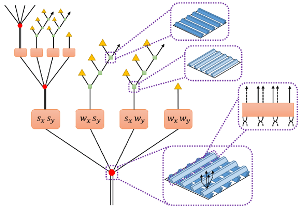Jan 19 2018
An international research team, which includes UvA physicist Michael Walter, has developed innovative techniques for forming intriguing input states for quantum simulations and computations. These innovative techniques can be adopted to simulate specific electronic systems to unpredictably high accuracy. The outcomes of the study have been reported this week in the Physical Review X journal.
 The quantum circuits that were designed in this research can be depicted in tree-like diagrams such as the one shown here. (Image credit: J. Haegeman et al)
The quantum circuits that were designed in this research can be depicted in tree-like diagrams such as the one shown here. (Image credit: J. Haegeman et al)
When considering information, we are usually reminded of classical computer bits: devices with the ability to store a “0” or a “1” and which can be controlled to perform computations. However, in the recent past, physicists have become increasingly interested in quantum information theory, in which the basic units of information are quantum bits, or qubits. Qubits, for instance, tiny spinning electrons, have two characteristics that render them more intriguing than their classical equivalents. One thing is that it is not necessary that they have to be precisely in the “0” or “1” state, for instance, spinning clockwise or counterclockwise. In contrast, they can be in more complex superpositions, something like “having a 30% probability of spinning clockwise and 70% of spinning counterclockwise.” Moreover, qubits can share information among themselves: the possibilities for one qubit can be reliant on the possibilities for another qubit—or in physical terms, the qubits are intertwined.
Simulating quantum physics
In conjunction, these two characteristics render quantum information highly flexible and prospectively highly dynamic than classical information. For instance, quantum computers can perform computations that cannot be performed by using ordinary computers even if we have billions of years of computing time—one classic example is code cracking by means of prime factorization of large numbers. However, quantum computers are not just helpful for solving mathematical problems. They can be even handy for use by physicists. For instance, simulating quantum systems is absolutely complicated in a normal computer. Owing to their very characteristic, next-generation quantum computers would be highly equipped to perform such simulations.
Latest advancements in gaining an in-depth knowledge behind the physics of quantum information have resulted in innovative techniques to simulate quantum physics, on prevalent classical computers as well as on next-generation quantum computers. Pivotal to these advancements are functional processes to create intriguing quantum states that could serve as the input for such simulations and computations. For instance, a specifically exhilarating aim is to characterize the physical characteristics of electron systems. Electronic characteristics are significant for chemistry as well as for materials science. However, these characteristics have been challenging to computing through conventional techniques.
Quantum circuits
At present, an international research team has achieved notable advancement in this area. One of the members of the team is Michael Walter, a UvA physicist who is at present an assistant professor at the QuSoft institute in Amsterdam, and who was earlier a postdoctoral researcher at Stanford, where a major portion of his research was performed.
Walter and his collaborators have gained knowledge from quantum information science, many-body physics, and signal processing to devise innovative preparation techniques for various non-trivial quantum states. The outcomes are of the form of “quantum circuits,” which are series of physical operations that create an interest state from a simple initial state. The paper specifically takes into account a category of metallic states which have been shown to be challenging to achieve due to their high quantum entanglement degree. The team has used its techniques to be successful in offering preparation processes for such states.
The new outcomes have been reported this week in Physical Review X, and are highly significant because the techniques are not only functional; the researchers can mathematically prove that they work. The outcomes are a stepping stone for next-generation quantum computations—the methods described in the paper will probably be a significant element in realizing more complicated electronic states incorporating the effects of electron interactions.